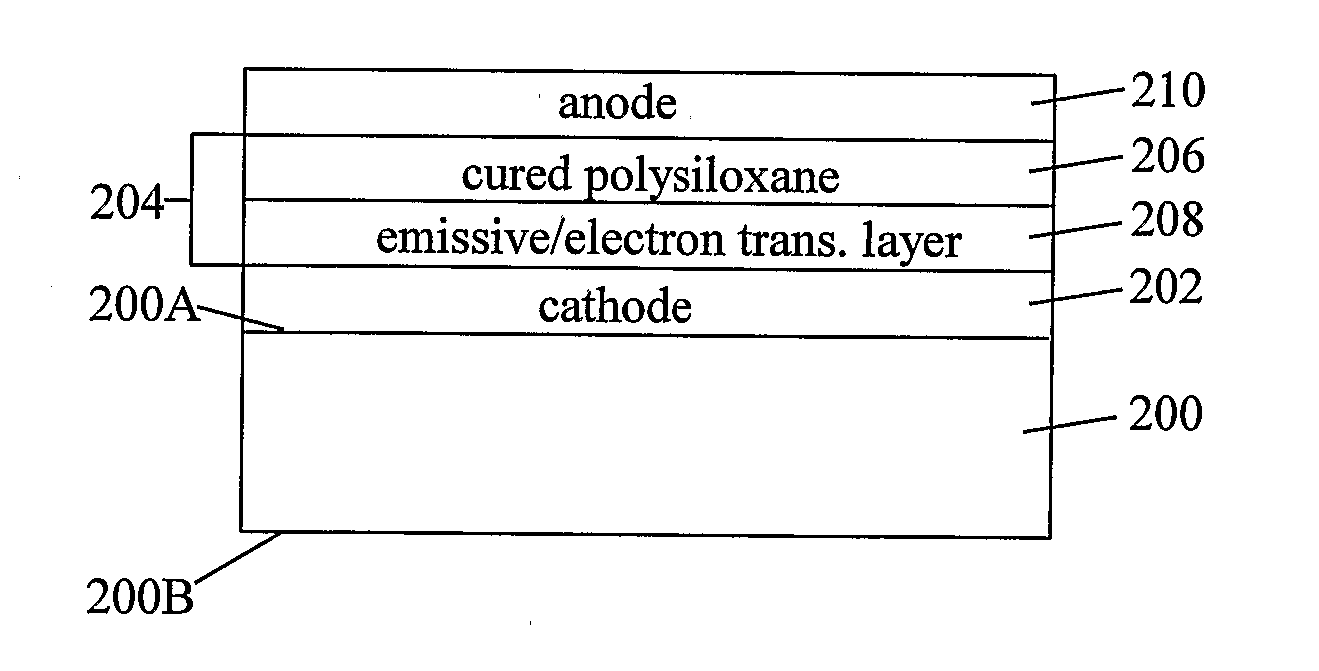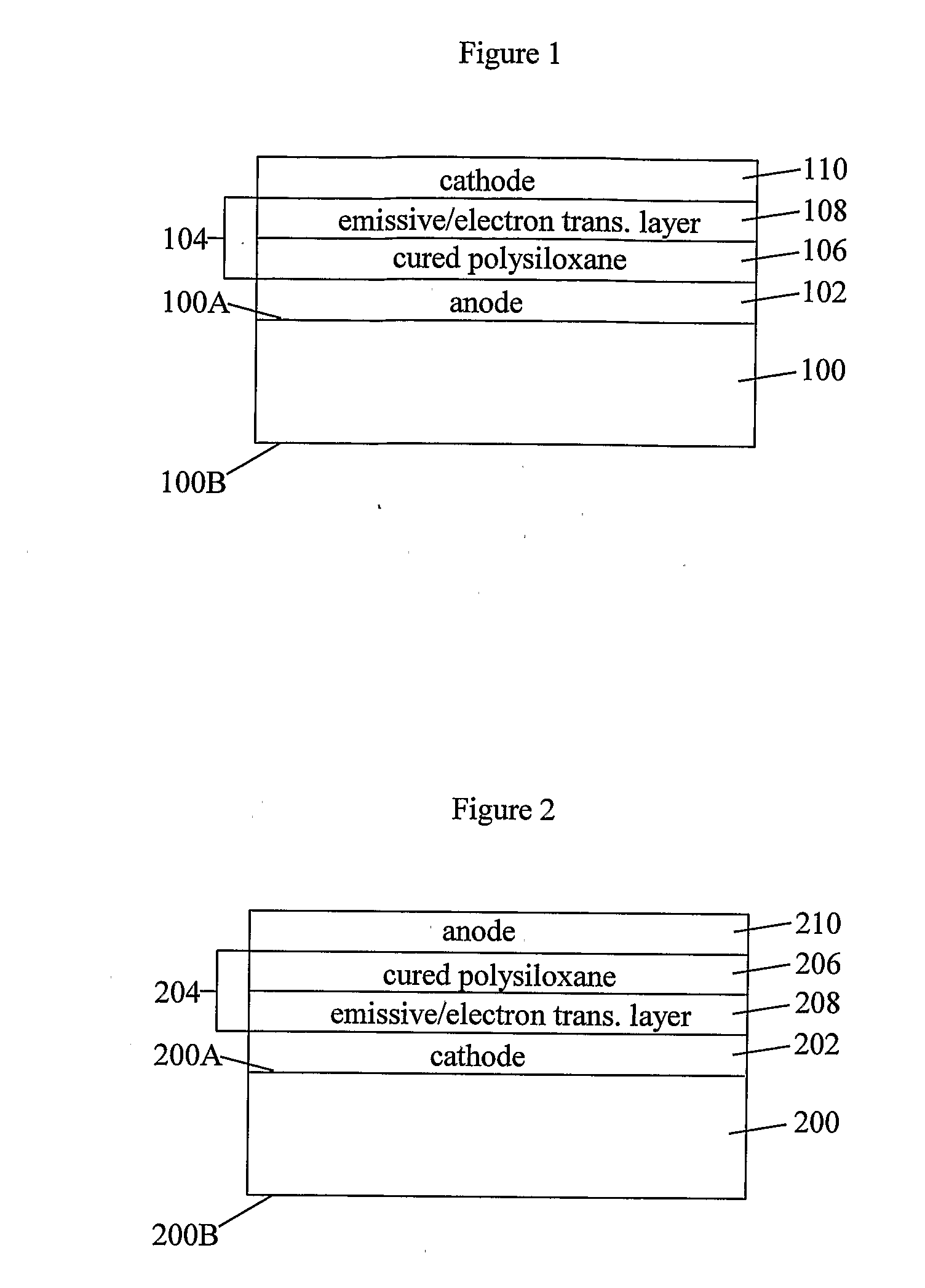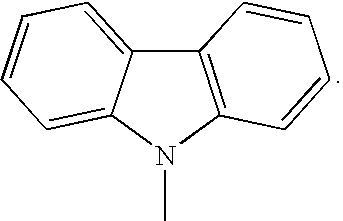Organic light-emitting diode
a light-emitting diode and organic technology, applied in the field of organic light-emitting diodes, can solve the problems of high acidity, low transparency, and many limitations of the hole-transport layer comprising pdot:pss, and achieve the effects of low turn-on voltage, high brightness, and high transparency
- Summary
- Abstract
- Description
- Claims
- Application Information
AI Technical Summary
Benefits of technology
Problems solved by technology
Method used
Image
Examples
example 1
[0071] Trichlorosilane (4.47 g), 5.52 g of allyl carbazole, and 5.5 g of anhydrous toluene were combined under nitrogen in a one-neck glass flask equipped with a magnetic stir bar. To the mixture was added 0.015 g of a solution consisting of 0.31% of 1,3-divinyl-1,1,3,3-tetramethyldisiloxane and 0.19% of a platinum complex of 1,3-divinyl-1,1,3,3-tetramethyldisiloxane in dry toluene. The mixture was heated under nitrogen at 60° C. for 1 h and then flushed with dry nitrogen at 60° C. for 10 min. The mixture was then distilled at about 220° C. under vacuum to produce 3-(N-carbazolyl)propyltrichlorosilane) as a colorless fluid, which formed transparent colorless crystals upon cooling to room temperature.
[0072] A portion (0.5 g) of the 3-(N-carbazolyl)propyltrichlorosilane) was dissolved in 9.5 g of toluene in a glass vial. A drop of the solution was applied to double-polished silicon wafer and the solvent was evaporated under a stream of dry nitrogen to form a thin film (4 μm). The FTI...
example 2
[0073] Four OLEDs (see figures below) were fabricated as follows: Silicon monoxide (100 nm) was thermally deposited along a first edge of a pre-cleaned ITO-coated glass substrate (25 mm×25 mm) through a mask having a rectangular aperture (6 mm×25 mm). A strip of 3 M Scotch brand tape (5 mm×25 mm) was applied along a second edge of the substrate, perpendicular to the SiO deposit. A solution consisting of 4% of 3-(N-carbazolyl)propyltrichlorosilane) and 1% of tetrachlorosilane in toluene was spin-coated (4,200 rpm, 20 s) over the ITO surface using a CHEMAT Technology Model KW-4A spin-coater to form a hole-transport layer having a thickness of 40 nm. The composite was exposed to the ambient air (30% RH) for 30 minutes, heated in an oven (air) at 100° C. for 90 min, and then allowed to cool to room temperature. A solution consisting of 1.5 wt % of LUMATION Blue BP79 Light-Emitting Polymer in mesitylene was then spin-coated (2250 rpm, 40 second) over the hole-transport layer to form an e...
example 3
[0074] Four OLEDs were fabricated as described in Example 2, except the hole-transport layer was prepared using a solution consisting of 5% of 3-(pentafluorophenyl)propyltrichlorosilane in toluene. Also, the hole-transport layer was spin-washed with mesitylene (4200 rpm, 20 s) prior to formation of the emissive / electron transport layer. Each of the four OLEDs emitted a blue color light and had a turn-on voltage at 1 cd m−2 of about 2.8 V, a brightness at 7 V of approximately 7700 cd m−2, and a peak luminous efficiency of 3.4 cd A−1.
PUM
 Login to View More
Login to View More Abstract
Description
Claims
Application Information
 Login to View More
Login to View More - R&D
- Intellectual Property
- Life Sciences
- Materials
- Tech Scout
- Unparalleled Data Quality
- Higher Quality Content
- 60% Fewer Hallucinations
Browse by: Latest US Patents, China's latest patents, Technical Efficacy Thesaurus, Application Domain, Technology Topic, Popular Technical Reports.
© 2025 PatSnap. All rights reserved.Legal|Privacy policy|Modern Slavery Act Transparency Statement|Sitemap|About US| Contact US: help@patsnap.com



